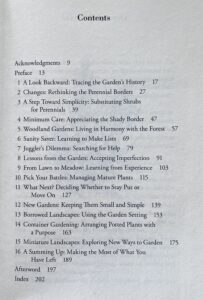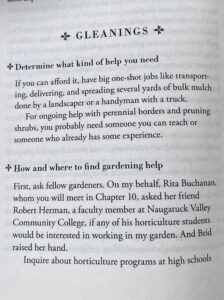
I didn’t happen upon this book by chance, it was purchased as part of a piece I was writing on the relationship between the processes of gardening and the processes of ageing. It was also as a result of my growing frustration (no pun intended), with the predominant focus of writing in this area leaning towards the downsides of getting older; on loss, on looking back, on bodily limitations and so on. In short, there seemed to be a general melancholic feel to the writing in this area.
One of the aims of any writer, I would argue, is to capture the reader, to draw them in and create an eagerness to turn the pages, to read more, to be a part of the journey that the writer has shared with you. The first line of Chapter 1 captured me; indeed, it was as though the line was written for me.
“It took a great deal of time and energy to make the garden as hard to manage as it ultimately became, and I loved every minute of it: every hour spent digging beds and planting shrubs, trees, and perennials; all the countless more hours of pruning, dividing, and moving plants around.”
It felt personal. It touched to the very heart of something that had been on my mind for some time. With that personal touch in mind, for the rest of the review, I will not refer to the author using her surname, but with her first name, Sydney. I might seem like a liberty on my part but there are no real consequences of me doing so, other than to allow me the feeling of writing back to Sydney herself (which I may try to do).
Our own garden is nowhere near on the scale of what Sydney’s was (and still is), but her sentiments echoed mine and I was eager to read on …
 The book has 16 short, readable chapters with catchy titles such as “Minimum Care: Appreciating the Shady Border”; “Sanity Saver: Learning to make lists”; Juggler’s dilemma: searching for help”; “Lessons from the garden: Accepting imperfection” … and so on. Each chapter ends with short sections headed “Gleanings” – which are, in essence a “What I’ve learned from this” section. These insights are concise, insightful and very helpful if you’re thinking about current or future alterations within your garden. The subheadings in the gleanings section will give an idea of the variety of hints/tips/learnings that Sydney has gleaned over the years. “Do your research”; Be suspicious of sizes given in nursery catalogues”; “The beauty of mulch and compost”; and so on. I was tempted to write more of these headings as they are well thought out and connect at a personal level … sod it! Here are a few more. “All of the pleasure for a fraction of the work”; “responding to change”; “Learning to make lists”; “Nonnative shade plants with style and stamina”. The last one was a goody in that it challenged my lexigraphic knowledge – what did “Nonnative” mean? Apparently, it means “foreign born” … now it makes sense.
The book has 16 short, readable chapters with catchy titles such as “Minimum Care: Appreciating the Shady Border”; “Sanity Saver: Learning to make lists”; Juggler’s dilemma: searching for help”; “Lessons from the garden: Accepting imperfection” … and so on. Each chapter ends with short sections headed “Gleanings” – which are, in essence a “What I’ve learned from this” section. These insights are concise, insightful and very helpful if you’re thinking about current or future alterations within your garden. The subheadings in the gleanings section will give an idea of the variety of hints/tips/learnings that Sydney has gleaned over the years. “Do your research”; Be suspicious of sizes given in nursery catalogues”; “The beauty of mulch and compost”; and so on. I was tempted to write more of these headings as they are well thought out and connect at a personal level … sod it! Here are a few more. “All of the pleasure for a fraction of the work”; “responding to change”; “Learning to make lists”; “Nonnative shade plants with style and stamina”. The last one was a goody in that it challenged my lexigraphic knowledge – what did “Nonnative” mean? Apparently, it means “foreign born” … now it makes sense.

Many writers, in exploring their lives in their own gardens, create a feeling of “otherness”, a sense that you are reading about a garden that, whilst entertaining and engaging, has no relation to your own experiences, your own gardening life. This is absolutely fine if one simply wants to glimpse those other garden worlds, but if you want to take something from a book and tailor it to potential use in your own space it is somewhat difficult. Not with this book.
I was smitten with the style of writing. It was as if Sydney had taken me to one side, sat me down and said, “David, let’s have a cup of tea and chat about your garden” – I was literally learning as I was reading.
The book is punctuated with short descriptions from Sydney’s own life. Her life with her husband, Martin; her relationships with various helpers/collaborators/friends and the influence they had on her gardening journey. The references to her life a with her husband are particularly poignant and provide a deeply personal context to the development of the garden. The subject of “loss” in its various stages is explored with both dignity and honesty. Unlike some other garden tomes, the loss in this instance, does not pertain to the inability to garden as one once did, but to personal, relational loss and life without Martin.
Perhaps it’s the “diary” style feel to the book that adds to its relatability.
There is a “down to earthiness” to the book. Sydney often refers to the challenges of working a larger than average garden with limited help … and the fact that she doesn’t have the financial resources to simply engage a full-time gardener.
There are some memorable quotes throughout the book. I hope that when you read through them you will get a sense of the delights hidden within.
“… the garden is most successful where the hand of the gardener is least in evidence” p80
“My garden is inseparable from the rest of my life, which included when Martin was alive in the house, two vehicles, the reigning Jack Russel Terrier, family, friends, and visitors from England.” P83
“Older people sometimes feel that age has diminished their worth, but one of the lovely things about gardening is that, in the eyes of young gardeners, age and experience confer status.” p85
Of all the lessons gardening has taught me, the hardest to digest inwardly has been the acceptance of imperfection”. P91
“Making the most of what you have left is also the older gardeners task. How beautiful can you make your garden with the resources you still have at your command? This is the question I keep asking myself. I don’t have the answer, but I’m working on it.” P196
The last quote epitomises the overall feel of the book. It is a beautifully crafted sentence that acts as a real salve to the gloomier offerings elsewhere.

This is a thoroughly engaging read which should have wide ranging appeal. I’m sure that my feelings about it come as no surprise given what’s in the review. However, I stand by my comments. It’s not a “How to garden when you’re old” book, but more of a “How to think about your garden as you age” book. As such, I read it at just the right time!
Easy to read, with high levels of “dip in/dip out” appeal. If you get the chance … read it!
Published by: Timber Press
Available on Amazon for £12.99
